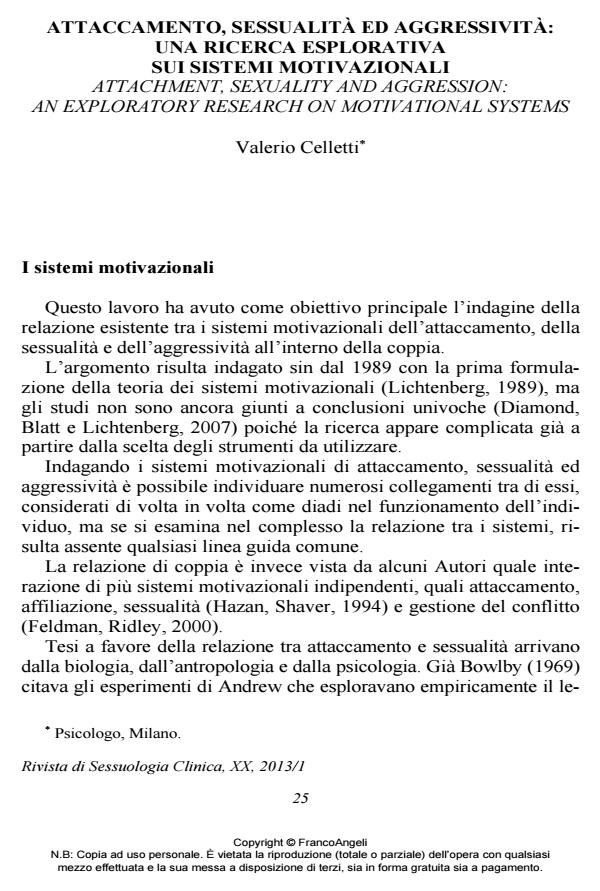Attaccamento, sessualità ed aggressività: una ricerca esplorativa sui sistemi motivazionali
Titolo Rivista RIVISTA DI SESSUOLOGIA CLINICA
Autori/Curatori Valerio Celletti
Anno di pubblicazione 2013 Fascicolo 2013/1 Lingua Italiano
Numero pagine 10 P. 25-34 Dimensione file 369 KB
DOI 10.3280/RSC2013-001002
Il DOI è il codice a barre della proprietà intellettuale: per saperne di più
clicca qui
Qui sotto puoi vedere in anteprima la prima pagina di questo articolo.
Se questo articolo ti interessa, lo puoi acquistare (e scaricare in formato pdf) seguendo le facili indicazioni per acquistare il download credit. Acquista Download Credits per scaricare questo Articolo in formato PDF

FrancoAngeli è membro della Publishers International Linking Association, Inc (PILA)associazione indipendente e non profit per facilitare (attraverso i servizi tecnologici implementati da CrossRef.org) l’accesso degli studiosi ai contenuti digitali nelle pubblicazioni professionali e scientifiche
In sessuologia il tema dell’aggressività nella sessualità è ampiamente studiato. Al contrario, gli effetti dell’attaccamento nella sessualità sono raramente discussi. I teorici dell’attaccamento fanno di frequente riferimento all’aggressività, piuttosto che alla sessualità. La teoria dei sistemi motivazionali potrebbe essere un quadro teorico adatto a studiarli insieme. Questa ricerca approfondisce la relazione tra questi tre sistemi (attaccamento, sessualità e aggressività) e propone una direzione per futuri studi.;
Keywords:Sessualità, attaccamento, aggressività, sistemi motivazionali, interazione, strumenti di valutazione.
- Ammaniti M., Nicolais G., Speranza A.M. (2007). Attachment and sexuality during adolescence: interaction, integration or interference. In: Diamond D., Blatt S.J., Lichtenberg J.D., eds., Attachment and Sexuality. New York: The Analytic Press, pp. 79-105
- Andrew R. (1964). The development of adult responses given during imprinting by the domestic chick. Animal Behaviour, 12, 4: 542-8. DOI: 10.1016/0003-3472(64)90078-8
- Boccadoro L. (1996). Manuale del Sesamo. Firenze: Organizzazioni Speciali.
- Bowlby J. (1969). Attachment and loss Vol. 1: Attachment. New York: Basic
- Books, (trad. it. Attaccamento e perdita. L’attaccamento alla madre Vol.1. Torino: Bollati Boringhieri, 1999).
- Buss A., Perry M. (1992). The Aggression Questionnaire. Journal of Personality and Social Psychology, 63, 3: 452-9. DOI: 10.1037/0022-3514.63.3.452
- Castellano R., Velotti P., Zavattini G.C. (2010). Cosa ci fa restare insieme? Bologna: Il Mulino.
- Christensen A., Shenk J.L. (1991). Communication, conflict and psychological distance in nondistress, clinic, and divorcing couples. Journal of Counsulting and Clinical Psychology, 59: 458-63. DOI: 10.1037/0022-006X.59.3.458
- Creasey G., Hesson-McInnus M. (2001). Affective responses, cognitive appraisals, and conflict tactics in late adolescent romantic relationships associations with attachment orientations. Journal of Counseling Psychology, 48: 85-96. DOI: 10.1037/0022-0167.48.1.85
- Crépault C. (1994). La sexoanalyse. Paris: Payot and Rivages (trad. it. La Sessoanalisi, alla ricerca dell’inconscio sessuale. Roma: FrancoAngeli, 2008).
- Crittenden P.M. (1999). Attaccamento in età adulta: l’approccio dinamicomaturativo all’Adult Attachment Interview. Milano: Raffaello Cortina.
- Crittenden P.M. (2008). Il modello dinamico-maturativo dell’attaccamento. Milano: Raffaello Cortina.
- Davis D., Shaver P.R., Vernon M.L. (2004). Attachment style and subjective motivations for sex. Personality and Social Psychology Bulletin, 30, 8: 1076-90. DOI: 10.1177/0146167204264794
- Diamond D., Blatt S.J., Lichtenberg J.D. (2007). Attachment and Sexuality. New York: Psychoanalytic Inquiry Book Series.
- Feeney B.C., Collins N.L. (2001). Predictors of caregiving in adult intimate relationships: an attachment theoretical perspective. Journal of Personality and Social Psychology, 80: 972-94. DOI: 10.1037/0022-3514.80.6.972
- Feeney B.C. (2004). A secure base: responsive support of goal strivings and exploration in adult intimate relationships. Journal of Personality and Social Psychology, 87: 631-48. DOI: 10.1037/0022-3514.87.5.631
- Feeney J.A., Noller P., Hanrahan M. (1994). Assessing Adult attachment. In: Sperling M.B., Berman W.H., eds., Attachment in adults: clinical and developmental perspectives. New York: Guilford, pp. 128-52.
- Feeney J.A. (2008). Adult romantic attachments: developments in the study of couple relationships. In: Cassidy J., Shaver P.R., eds., Handbook of attachment: theory, research, and clinical applications. New York: Guilford Press, pp. 456-81.
- Feldman C.M., Ridley C.A. (2000). The role of conflict-based communication responses and outcomes in male domestic violence toward female partners. Journal of Social and Personal Relationships, 17, 4-5: 552-73. DOI: 10.1177/0265407500174005
- Fincham F.D., Beach S.R.H. (1999). Conflict in marriage: implications for working with couples. Annual Reviews of Psychology, 50: 44-77. DOI: 10.1146/annurev.psych.50.1.47
- Fraley R.C., Shaver P. (1997). Adult attachment and the suppression of unwanted thoughts. Journal of Personality and Social Psychology, 73: 1080-91. DOI: 10.1037/0022-3514.73.5.1080
- Hazan C., Shaver P.R. (1994). Attachment as an organizational framework for research on close relationships. Psychological Inquiry, 5: 1-22. DOI: 10.1207/s15327965pli0501_1
- Kaplan H.S. (1981). I disturbi del desiderio sessuale. Milano: Mondadori.
- Lichtenberg J.D. (1989). Psychoanalysis and Motivation. Hillsdale, N.J.: The Analytic
- Press (trad. it. Psicoanalisi e sistemi motivazionali. Milano: Cortina, 1995).
- Marchand J.F. (2004). Husbands “and wives” marital quality: the role of adult attachment orientations, depressive symptoms, and conflict resolution behavior.
- Attachment and Human Develompment, 6: 99-112. DOI: 10.1007/s10804-005-1324-z)
- Mikulincer M., Goodman G.S. (2006). Dynamics of romantic love: attachment, caregiving, and sex. New York: Guilford Press.
- Pietromonaco P.R., Greenwood D., Feldman Barrett L. (2004). Conflict in adult close relationships: an attachment perspective. In: Rholes W.S., Simpson J.A.,
- eds., Adult attachment: new directions and emerging issues. New York: Guilford Press, pp. 267-99.
- Remotti F. (2008). Contro natura. Una lettera al Papa. Roma-Bari: Laterza.
- Richters J., de Visser R., Rissel C., Grulich A., Smith, A. (2008). Demographic and psychosocial features of participants in bondage and discipline, “sadomasochism” or dominance and submission (BDSM): data from a national survey. Journal of Sexual Medicine. 5: 1660-8. DOI: 10.1111/j.1743-6109.2008.00795.x
- Shane M., Shane E., Gales M. (1999). Sesso, sessualizzazione e il feargasm. Un approccio alla sessualità secondo la psicologia del sé e la teoria dei sistemi dinamici evolutivi. Rivista Italiana Telematica di Psicologia Psicoanalitica del Sé, Intersoggettività, Psicoanalisi Relazionale, 3: 1.
- Shaver P., Mikulincer M. (2002). Attachment-related psychodynamics. Attachment and Human Development, 4: 133-61. DOI: 10.1080/14616730210154171
- Simonelli C., a cura di (2006). L’approccio integrato in sessuologia clinica. Milano: FrancoAngeli.
- Stechler G., Kaplan S. (1980). The development of the self: a psychoanalytic perspective. Psychoanalytic Study of the Child, 35: 85-106.
Valerio Celletti, Attaccamento, sessualità ed aggressività: una ricerca esplorativa sui sistemi motivazionali in "RIVISTA DI SESSUOLOGIA CLINICA" 1/2013, pp 25-34, DOI: 10.3280/RSC2013-001002